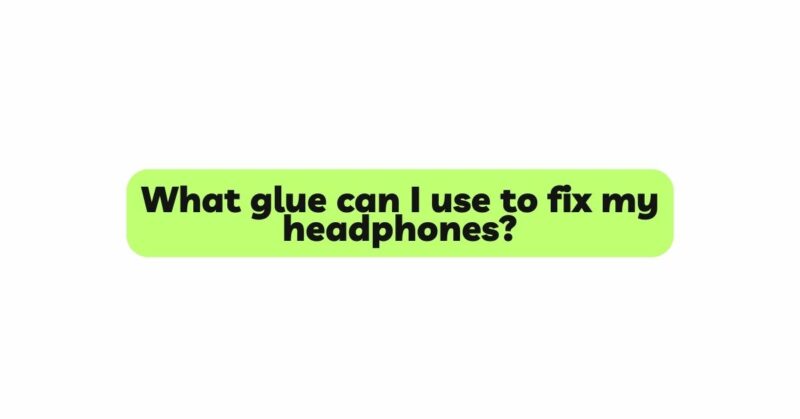Headphones have become an inseparable part of our daily lives, offering an escape into a world of music, podcasts, and audio content. Unfortunately, accidents can happen, leading to damaged components and compromised audio quality. The prospect of repairing headphones prompts headphone owners to explore various adhesive options. With an overwhelming variety of glues available, it becomes crucial to identify the right adhesive for fixing headphones effectively. In this article, we will delve into the different types of glues suitable for headphone repairs, their specific applications, and the benefits and drawbacks of each. From headband fractures to detached ear pads and cable issues, we will guide you through the process of making an informed decision and salvaging your beloved audio companions with the right adhesive.
- Understanding the Different Types of Headphone Damage:
Before selecting an appropriate glue for headphone repairs, it is essential to understand the types of damage that may occur:
- Physical Damage: This includes visible cracks, fractures, or deformities on the external parts of the headphones, such as ear cups, headbands, or connectors. Physical damage often results from accidental drops, impacts, or rough handling.
- Driver Issues: The drivers are the core components responsible for producing sound in headphones. Driver issues may include misalignment, diaphragm deformation, or voice coil problems, leading to distorted or non-functional sound.
- Cable and Connector Problems: Headphone cables and connectors are vulnerable to fraying, bending, or disconnection, resulting in audio disruptions or a complete loss of sound.
- Evaluating Different Types of Glues for Headphone Repairs:
Various types of glues are suitable for different headphone repair scenarios. Here are some common types of glues and their applications:
a. Super Glue (Cyanoacrylate Adhesive):
Pros:
- Quick Bonding: Super glue forms strong bonds rapidly, making it suitable for immediate repairs.
- Versatility: It can bond various materials, making it useful for fixing different headphone components.
Cons:
- Lack of Flexibility: Once dried, super glue becomes rigid and lacks flexibility, which may not be suitable for components that require movement.
- Potential Mess: Super glue can create a mess if not applied carefully, and excess glue may damage headphone surfaces.
b. Epoxy Adhesive:
Pros:
- Strong and Durable: Epoxy adhesive provides a robust bond and long-lasting durability, making it suitable for repairing headphone components subjected to stress or movement.
- Heat and Chemical Resistance: Epoxy adhesive exhibits resistance to heat and chemicals, making it ideal for headphones used in various environments.
Cons:
- Slow Curing Time: Epoxy adhesive may have a longer curing time compared to other glues.
c. Rubber Cement:
Pros:
- Flexibility: Rubber cement remains flexible even after drying, making it suitable for components that require movement.
- Reversible Bond: Rubber cement allows for easy adjustment and removal of components if needed.
Cons:
- Lower Strength: Rubber cement may not provide as strong a bond as some other adhesives.
d. Hot Glue (Hot Melt Adhesive):
Pros:
- Quick Bonding: Hot glue bonds quickly and can be applied easily with a hot glue gun.
- Versatility: Hot glue can bond various materials and can be used for temporary repairs.
Cons:
- Lack of Durability: Hot glue may not provide a long-lasting solution for headphone repairs, especially for components subjected to stress.
- Selecting the Right Glue for Specific Headphone Repairs:
Based on the types of headphone damage, here are the appropriate glues for specific repairs:
- Headband Repairs: For headband fractures or cracks, epoxy adhesive is an excellent choice due to its strong bond and durability.
- Ear Pad Attachment: To reattach detached ear pads, super glue or rubber cement can be used. Super glue is suitable for a quick fix, while rubber cement allows for easy adjustment and removal if necessary.
- Cable and Connector Repairs: For cable and connector problems, epoxy adhesive or hot glue may be used. Epoxy adhesive provides a strong and durable bond, while hot glue can offer a quick fix for temporary repairs.
- Precautions When Using Glues for Headphone Repairs:
Regardless of the type of glue used for headphone repairs, certain precautions are essential:
- Clean Surfaces: Ensure that the surfaces to be bonded are clean, dry, and free of any dirt or debris. This will promote better adhesion.
- Apply a Small Amount: Use a minimal amount of glue to avoid excess spillage and to prevent damage to other headphone components.
- Hold in Place: Hold the repaired components firmly in place for the appropriate curing time to allow the glue to bond properly.
- Seeking Professional Repairs:
For complex or irreparable headphone damage, seeking professional repairs from the manufacturer or authorized service center is often the best course of action. They have the expertise and access to genuine replacement parts, ensuring proper restoration of your headphones.
- Upgrading to New Headphones:
If the damage to your headphones is extensive or the repair efforts prove unsuccessful, consider upgrading to a new pair that suits your audio preferences and budget.
Conclusion:
Choosing the right glue for headphone repairs is essential to ensure effective bonding and lasting results. Based on the type of headphone damage, consider the pros and cons of each adhesive type to make an informed decision. Super glue and epoxy adhesive are suitable for various repairs, while rubber cement and hot glue can serve specific purposes. By following precautions and selecting the appropriate adhesive for your headphone repairs, you can salvage your cherished audio companions and continue to enjoy an immersive world of music and sound. Remember, when in doubt or dealing with complex damage, seek professional assistance to ensure the best outcome for your headphones.


